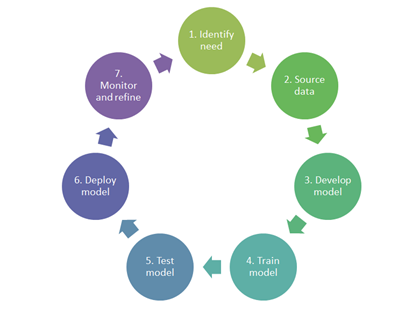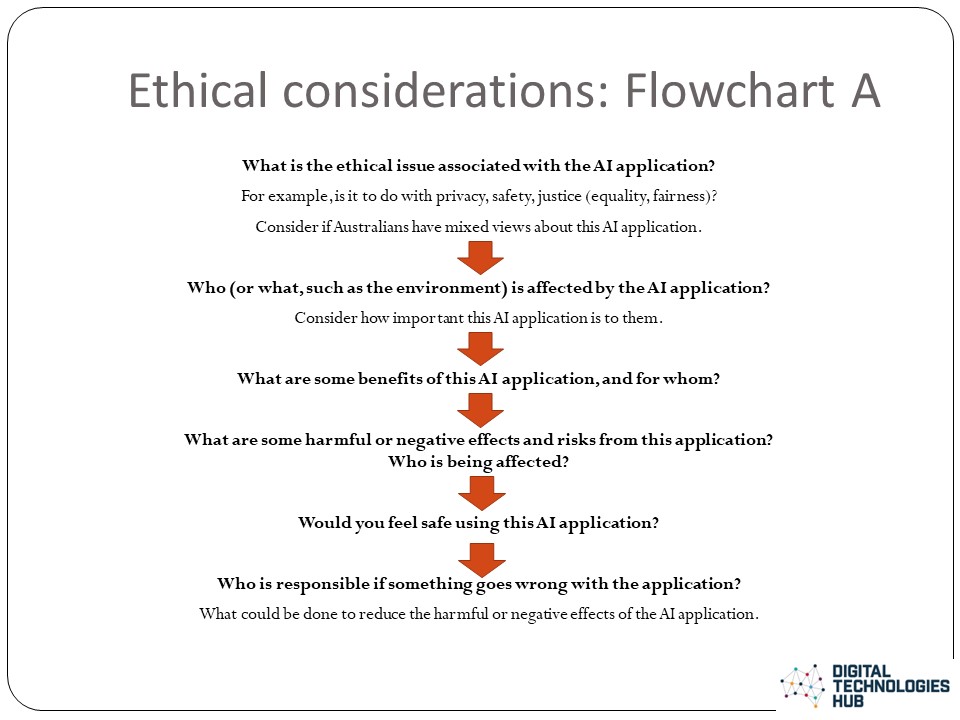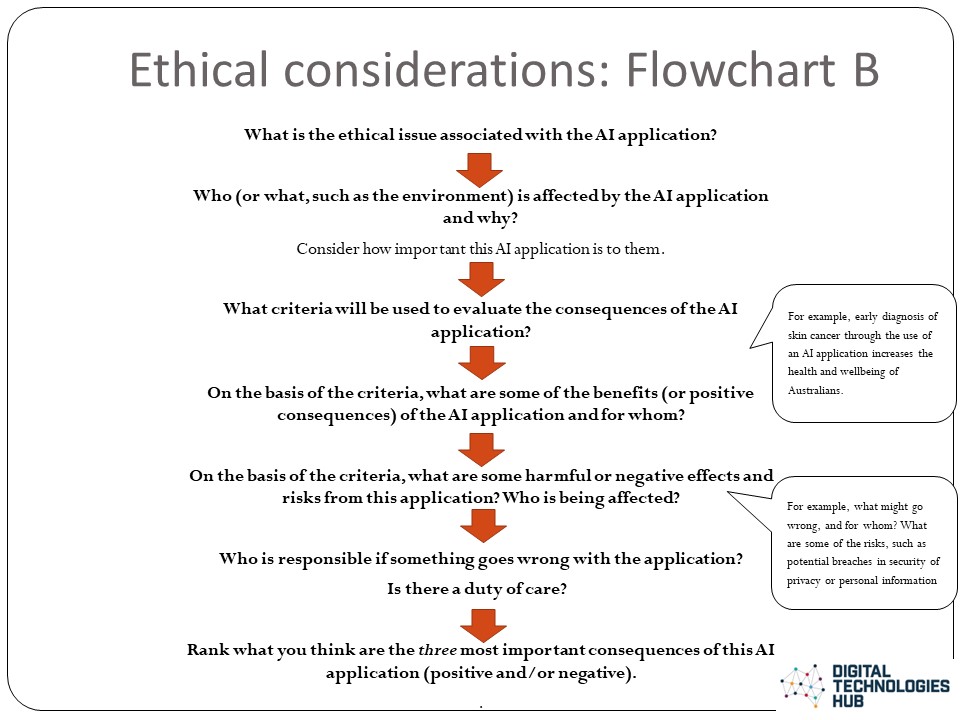Analysis of AI applications, drawing on ethical understandings

About this lesson
This lesson plan explores the ethical aspects of artificial intelligence and the implications on our future lives. This lesson was developed by the Digital Technologies Institute in collaboration with the DT Hub.
Year band: 5-6, 7-8
Curriculum Links AssessmentCurriculum Links
Links with the Digital Technologies Curriculum Area.
| Year | Content Description |
|---|---|
| 5-6 |
Evaluate existing and student solutions against the design criteria and user stories and their broader community impact (AC9TDI6P06) |
| 7-8 |
Evaluate existing and student solutions against the design criteria, user stories and possible future impact (AC9TDI8P10) |
Ethical Understanding
Typically, by the end of Year 6, students:
Recognise ethical concepts
- Examine and explain ethical concepts such as truth and justice that contribution to the achievement of a particular outcome.
Reason and make ethical decisions
- Explore the reasons behind there being a variety of ethical positions on a social issue.
Evaluate the consequences of actions in familiar and hypothetical scenarios.
Examine values
- Examine values accepted and enacted within various communities.
Typically, by the end of Year 8, students:
Explore ethical concepts in context
- Analyse the ethical dimensions of beliefs and the need for action in a range of setting.
Reason and make ethical decisions
- Analyse inconsistencies in personal reasoning and society ethical decision making.
Examine values
- Assess the relevance of beliefs and the role and application of values in social practices.
Source: Australian Curriculum, Ethical Understanding general capability
Assessment
Teacher assessment
Assess against these elements of the achievement standard for the relevant year level. Note ‘needs’ can include the ethical needs of a community.
| Level | Achievement standard |
|---|---|
| Years 5-6 | By the end of Year 6 students explain how people design products, services and environments to meet the needs of communities, including sustainability. |
| Years 7-8 | By the end of Year 8 students explain how people design, innovate and produce products, services and environments for preferred futures. |
Undertake formative assessment as students progress through the task, and provide them with feedback on their analysis.
Use the evidence provided in the Analysis worksheet: Ethical considerations to decide if more learning needs to occur about the nature of ethical issues and the processes that will help identify the consequences, the risks and the responsibilities of AI applications. Students’ ethical understandings need to progress beyond just identifying good and bad points about AI applications.
Listed are some questions that might guide your decision about the depth of students’ ethical understandings.
- Is there an understanding of the key ethical principles or values, such as privacy, rights, freedom, fairness?
- Is there evidence of reasoning? Can the students see the AI application from different perspectives?
- Have students been able to establish who has the duty of care regarding the AI application. Who has the responsibility for decision-making?
- Are the stated consequences consistent with the evidence provided in the scenario?
Preliminary notes
Key terms
| Key term | Definition |
|---|---|
| Artificial intelligence (AI) | The ability of machines to mimic human capabilities in a way that we would consider 'smart'. |
| Machine Learning | An application of AI and a process we give the machine lots of examples of data, demonstrating what we would like it to do so that it can figure out how to achieve a goal on its own. The machine learns and adapts its strategy to achieve this goal. |
| Ethical issue | A situation where there are competing alternatives and the right thing to do is not obvious or clear. Sometimes terms such as good, bad, wrong, better or worse are used to consider the effect of particular actions on our lives, society, nature and the environment. |
| Ethical behaviour | Acting according to accepted standards of conduct |
Preparation
Print out sufficient copies of the worksheets in the 'Resources' section.
Background: Artificial Intelligence (AI)
Artificial Intelligence (AI) is the ability of machines to mimic human capabilities in a way that people would consider 'smart'. Machine Learning (ML) is an application of AI. With ML, the machine is given many examples of data, demonstrating what people would like the machine to do so that it can figure out how to achieve a goal on its own. The machine learns and adapts its strategy to achieve this goal.
The lifecycle of an AI application includes stages that incorporate development and deployment based around ethical considerations. A typical lifecycle may include the following key stages:

An AI application makes decisions purely on the basis of its training and its input data. How could an AI become aware of ethical-decision making? Possible avenues of exploration are:
- training the AI in an ethical process that provides feedback when the AI behaves unethically
- using a second AI (ethics-AI) to watch over the output of the AI and intervene if the AI makes unethical decisions – acting like a conscience
- comparing an AI’s decision-making process to some of the ways humans make ethical decisions.
Implementing the lesson
There are four parts to this lesson and Parts 1 and 2 are common for Years 5 and 6 and Years 7 and 8 students. Parts 3 and 4 have slightly differently requirements for each of the bands. In summary, the lesson involves students:
- viewing an introductory video to AI and machine learning and discussing who is affected most by this AI application and its significance in terms of possible risks.
- discussing broadly three provided scenarios to stimulate thinking about any ethical issues associated with AI applications. The discussion could involve students considering what values-based criteria (or guiding principles) to use when determining the positive and negative (or harmful) consequences of using AI in each of these scenarios. Criteria could focus on values such as equality, privacy and rights, and it is sometimes easier for students to couch these criteria as questions, such as ‘does the AI application discriminate against specific people or objects so they are missing out on a benefit?’ (Alternatively, use some of your own AI scenarios if they better suit your students' needs and interests.)
- using a flow chart to support and guide their ethical understandings as they relate to AI. Note: There are two flow charts — Flow chart A might be more appropriate for Years 5 and 6 students and Flow chart B might better suit Years 7 and 8 students as the questions increase in their complexity.
- completing a worksheet (provided) to record their analysis of one of the AI scenarios discussed in Part 2. Years 5 and 6 teachers might decide that their students do not have to complete the final cell on this worksheet as it is more appropriate to Years 7 and 8 (insert content description code).
Learning map and outcomes
Increased proficiency in both analysing how existing AI systems meet needs, affect people, and change society and the world, and in predicting the effects of future systems.
Development of ethical understanding through analysis of AI systems and related questioning about their lifecycle. These ethical understandings include:
- Understanding ethical concepts and issues
Students learn to recognise ethical concepts and explore ethical issues in context. They identify, examine and give examples of ethical concepts. They discuss, analyse and explore dimensions of ethical concepts in context.
- Reason and make ethical decisions
Students consider the consequences of and reflect on ethical action. They analyse the reasoning behind stances when making ethical decisions and evaluate the intended and unintended consequences of actions in an increasing range of scenarios.
- Examine values
Students use instances of expressed values to explain social interactions and to determine rights and responsibilities in social and legal domains. They recognise and interpret points of view in ethical contexts.
Adapt this learning map to suit your student’s needs. For example for students at Year 6, a learning map might look like:
| By the end of this lesson students will: | Mindset | Skillset | Toolset |
|---|---|---|---|
|
Develop an understanding of information systems that include an AI application. Explain how AI systems can impact on society both positively and negatively. Apply ethical understanding as they respond to examples of AI systems. |
Analytical, Reflective, Curious | Collaborating, Clarifying |
Scenarios describing AI applications supported by media (video and/or online articles) Flow chart to support ethical analysis Worksheet to record ideas |
Learning hook
Introducing AI applications (part 1)
Ask students to think about the potential for using AI and who in society (or what in the environment) might benefit from its implementation.
Explain that as with any technology there may be risks and/or injustices associated with its use.
View the video AI: Impact on Society, which provides an introduction to ML and raises possible risks associated with this powerful technology.
Learning input
Introduce AI applications using three scenarios (part 2)
Briefly introduce the following AI scenarios:
- Scenario 1: Face recognition using the example of Airport check in and passport check
- Scenario 2: AI powered skin cancer app
- Scenario 3: Self-driving cars (autonomous vehicles)
Invite students to select an AI of interest to investigate the benefits, risks and possible impacts of the technologies.
Provide printed worksheets for each scenario or provide digitally to enable student to view online resources.
Some students may need guidance to view suggested videos and discuss these applications.
Prompt students to think about the criteria they could use to help make informed assessments about the benefits and negative consequences of the AI application in their chosen scenario. They should be encouraged to have more to say than simply a consequence is good or bad—they should be considering the relevant ethical values.
Learning construction
Using flow charts to guide evaluation of AI application (part 3)
Ask students to refer to the AI application they have chosen to evaluate. Provide students with the relevant flow chart to assist and guide them to analyse the AI application.
Two flow charts are provided to support and guide students as they consider questions that draw on ethical understanding. Select the appropriate flowchart to present to your class:
- Flow chart A would be more suited to Years 5-6 students
- Flow chart B would better suit Years 7-8 students as the questions increase in their complexity.
Discuss each question on the flow chart with the aim of providing and eliciting related concrete examples. Elaborate as necessary to ensure student understanding. You can relate these questions back to a scenario already discussed or make the discussion more general in nature.


Completing a worksheet: analysis of AI application (part 4)
Provide students with the Analysis worksheet Ethical considerations. Select the relevant version for your students:
Students will complete the worksheet by selecting and analysing their selected AI application.
Students respond to the key prompts, drawing on the questions posed in their flow chart.
At the completion of the task, have students share what they have identified as positive and negative consequences of the AI application as well as their suggestions for how the issues may be addressed and avoided/mitigated.
Resources
- AI impact on society video
- Australian Government Department of Industry, Science, Energy and Resources web page: AI ethics principles
- Case study: What would my preferred AI future look like?
- Digital Technologies Hub Artificial Intelligence topic page, and AI lesson plans
- Worksheet: Analyse an AI application: Considering ethical design and impacts
- Worksheet: AI scenarios
- Worksheet: Years 5-6
- Worksheet: Years 7-8
- Flow chart A
- Flow chart B